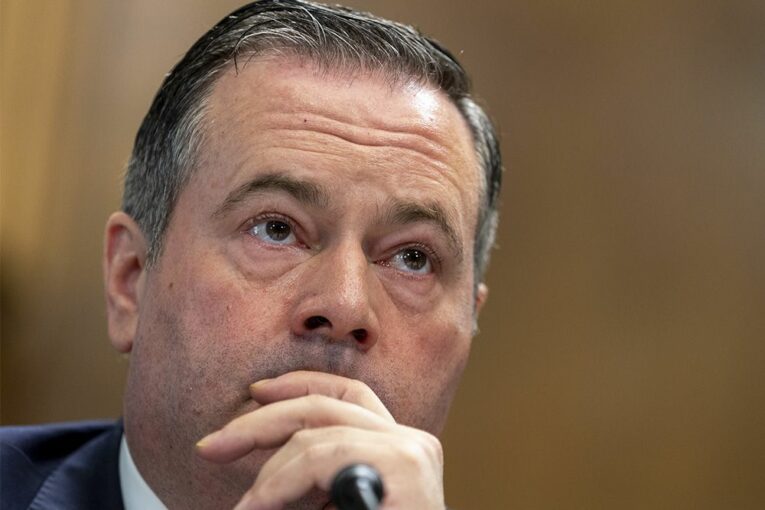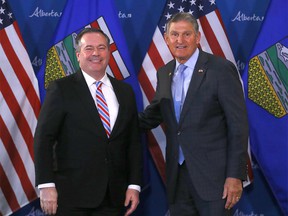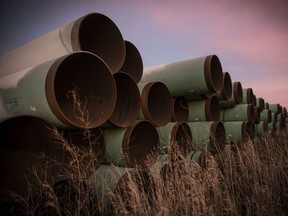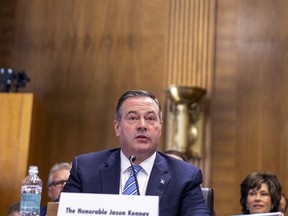
How many times can Keystone XL be left for dead and then revived?
On the political front, there is apparently no statute of limitations for such attempts as the defunct oil project still casts a long shadow over discussions involving Canada’s energy relationship with the United States.
Premier Jason Kenney appeared in front of the U.S. Senate energy committee Tuesday to promote greater co-operation between the countries. Both nations are grappling with the implications of Russia’s invasion of Ukraine and increasing concerns about global energy security.
While Kenney acknowledged Keystone XL is “done and dusted,” he wants to restart the conversation about developing a new pipeline between Alberta and the United States at a time of record gasoline prices and oil trading above US$112 a barrel.
“Alberta will be able to increase our crude exports to the U.S. by upwards of a million barrels a day over the next couple of years, helping to reduce prices at the pump,” Kenney said during the hearing in Washington, D.C.
“Let’s work together to see, can we bring back something like another major pipeline between Alberta and the United States?”
The hearing in front of committee chair Joe Manchin, the Democratic senator from West Virginia who visited Alberta last month, was intended to explore ways to strengthen the energy and mineral partnership between the countries.

As Manchin noted, the relationship is strong, although not without its challenges.
For example, the battle continues over Enbridge’s Line 5 pipeline, which Michigan’s governor is attempting to shut down.
Energy trade between the two countries is extensive. Canada is the largest foreign supplier of oil to the United States, our dominant international energy customer.
The value of all energy traded between the two countries (including natural gas, electricity and oil) jumped by 76 per cent last year to reach $102 billion.
Total U.S. oil imports from Canada last year averaged 3.9 million barrels per day (bpd), an increase of 300,000 from a year earlier.
“If we really work together, we could get you a couple of million more barrels a day of Canadian energy,” said Kenney.
The two-hour hearing, which included federal Natural Resources Minister Jonathan Wilkinson, saw support from senators for greater co-operation.
Canada and the U.S. are large energy producers. Both are trying to help European allies such as Germany and France pivot away from Russian oil and natural gas.
Then, there’s the Keystone XL file.
During the hearing, plenty of flack was directed toward the White House from Republican senators over the project’s cancellation.
First proposed in 2008, Keystone XL (KXL) would have shipped 830,000 barrels of oil per day from Alberta to refineries on the U.S. Gulf Coast.
It was rejected by the Obama administration and revived under Donald Trump, before President Joe Biden cancelled the pipeline’s cross-border permits in 2021.

The Alberta government has many reasons for not letting the KXL issue go: more than a billion, in fact.
Two years ago, the province invested in the development, led by Calgary-based TC Energy, to get construction started. The Kenney government has estimated its losses at $1.3 billion.
Yet, even without the project, more oil is headed south.
The premier said the current pipeline network has the ability to ship more oil, with about 300,000 bpd of unused capacity. Pipeline operators could add another 400,000 bpd through optimization, line reversals and debottlenecking efforts, while crude-by-rail capacity is also available.
U.S. senators appeared on board with calls for expanded energy flows with Canada, instead of asking OPEC to pump more oil.
“Look to your neighbours first — and for some strange reason, we have not done that,” said Sen. Lisa Murkowski of Alaska.
While Kenney touted Alberta’s ability to crank up output to fill new pipelines, the federal resources minister delivered a much different message.
Efforts by the U.S. and Canada to expand oil and gas exports to Europe are appropriate, but the shift to renewable energy and hydrogen “will provide true energy and national security to Europe — and to both our countries,” Wilkinson told the senators.
“Folks who say, ‘Well, energy security has come to the fore, (that) it’s so important that we just have to forget about climate change,’ well, they are forgetting about the science, the science of climate change,” he said in an interview.
Kenney and Wilkinson do share common ground about the role Canada can play to produce critical minerals required for the energy transition. They also agree on the need to keep Line 5 operating.
But the premier wants the U.S. to consider a new oil pipeline connecting it to Alberta, something Keystone XL was expected to do.
“It’s done and dusted, KXL is behind us,” he added. “But I hope that the invasion of Ukraine and the imperative of energy security causes a fundamental rethink about these issues in Washington.”

The foundation of the energy relationship between Canada and the U.S remains strong, said Ben Cahill, senior fellow on energy security at the Centre for Strategic and International Studies, a Washington-based think-tank.
Yet, there is still a fierce debate surrounding Keystone XL, which has turned into a powerful political symbol in the U.S.
“Personally, I think the market moved on years ago, but some political leaders haven’t,” Cahill said.
“Keystone XL is a zombie pipeline that won’t die. It keeps coming back.”
Christine Tezak, managing director of research at ClearView Energy Partners, said with the Trans Mountain expansion under construction and the potential for future pipeline optimization projects, she’s skeptical another major oil conduit is needed.
“Another greenfield line would be very tough to sell to investors in a carbon-constrained world.”
However, that won’t stop Alberta’s premier from trying to revive it, or the debate on Keystone XL from continuing to churn.
While the megaproject is dead, it’s far from buried in the province — or within the political bedrock south of the border.
Chris Varcoe is a Calgary Herald columnist.
You can read more of the news on source
